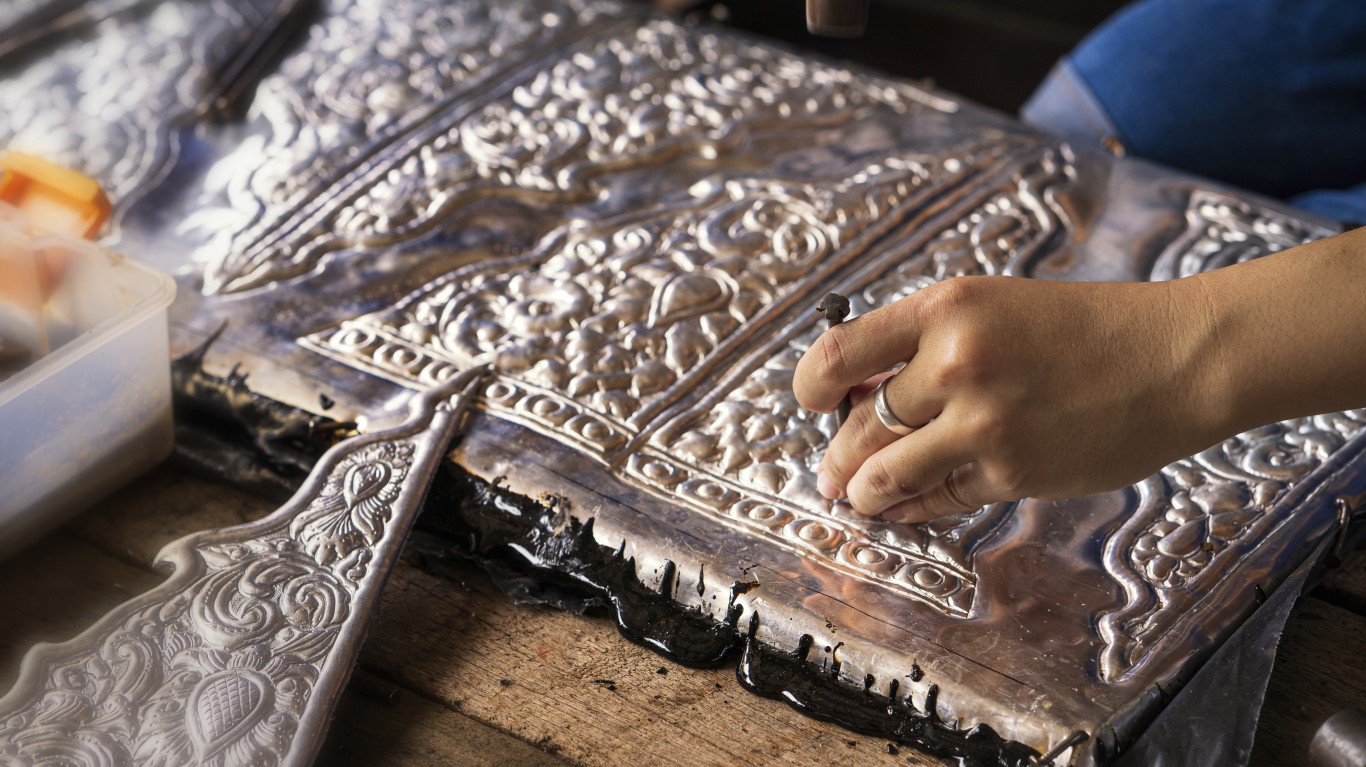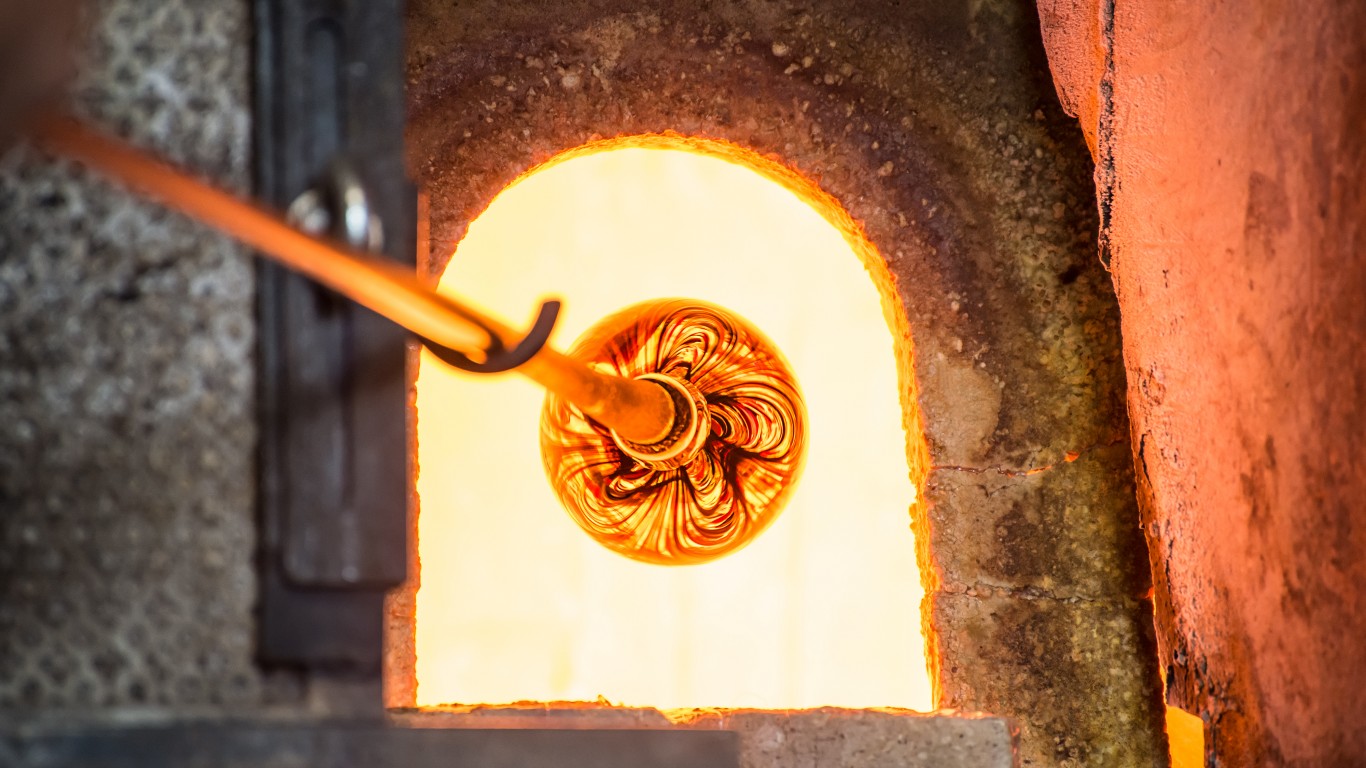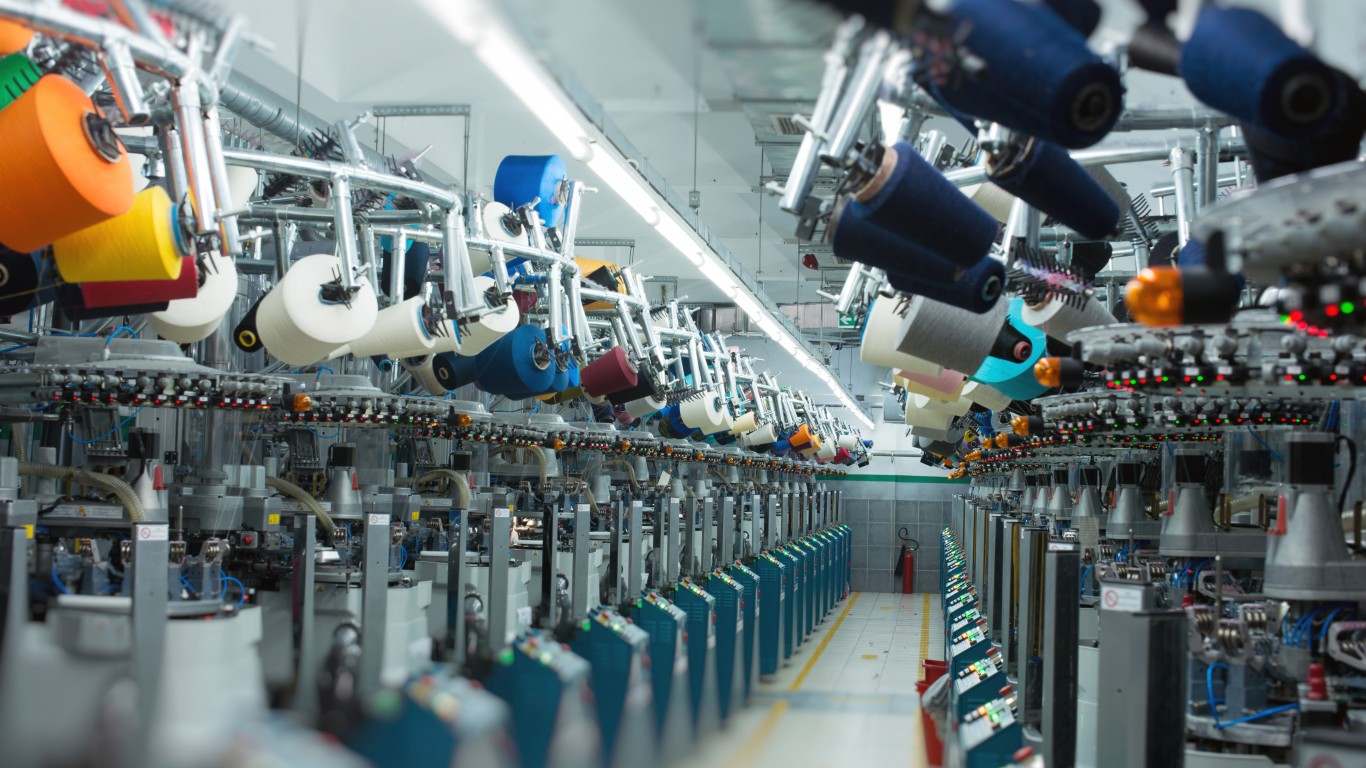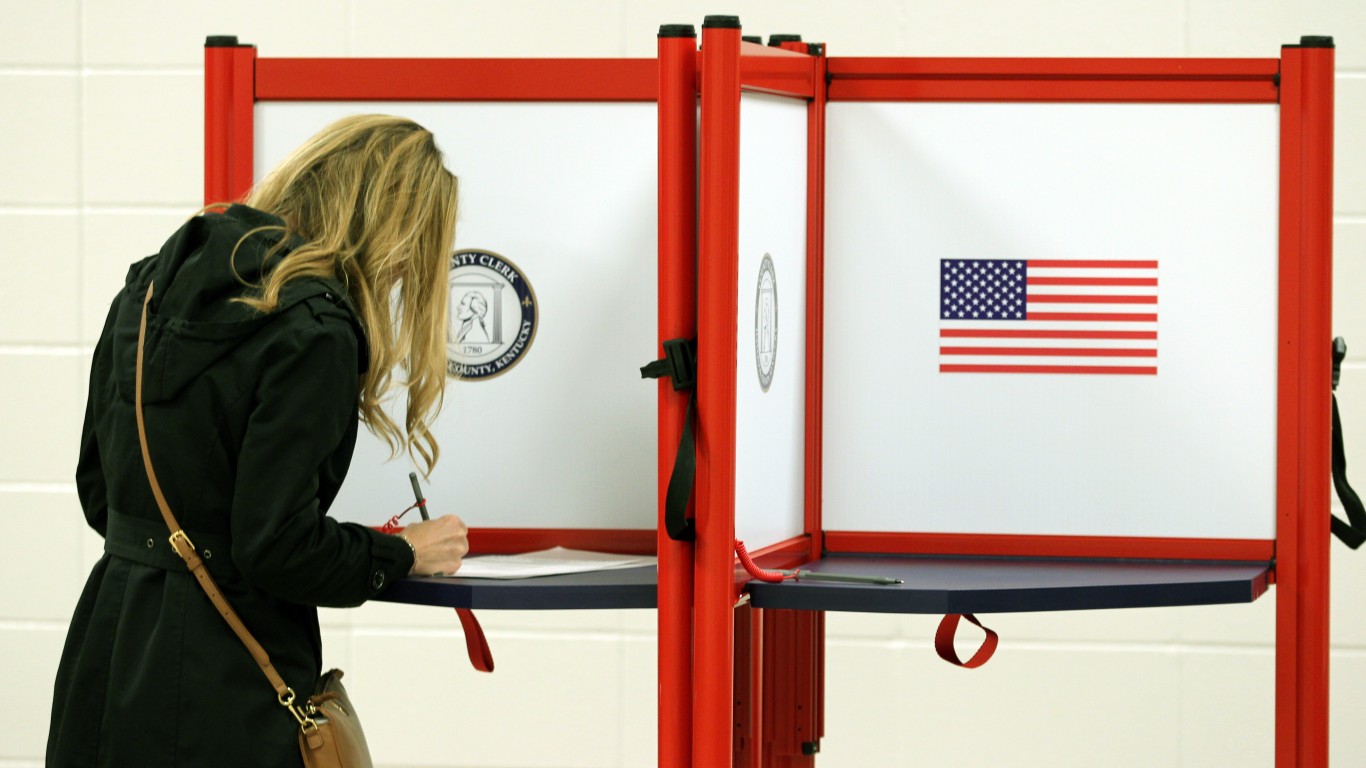
In a ruling on June 1, the U.S. Supreme Court made it easier for companies to sue unions representing their workers. The decision, which favored Washington state concrete company Glacier Northwest over International Brotherhood of Teamsters Local Union No. 174, was seen as a major setback to labor organizing in the United States.
While organizers have won some key victories in recent years, such as the formation of the Amazon Labor Union and dramatic rise in union filings by Starbucks workers last year, labor union activity has continued to fall. Union membership among U.S. workers has decreased from 20.1% in 1983 to 10.1% in 2022.
Just over 200 broad occupations employing tens of millions of people in the U.S. had less than 5% union membership in 2022. 24/7 Wall St. identified the 27 jobs with virtually zero union membership. We reviewed estimates of union membership, coverage, density, and employment by occupation from the union statistics database, Unionstats. We only considered occupations with employment of 10,000 or higher. Unionstats sample includes employed wage and salary workers, ages 16 and over.
Many of the occupations on this list, such as exercise trainers, small engine mechanics, and jewelers, often have a higher proportion of self-employed individuals. Self-employed workers typically have greater autonomy over their work and may not seek or have the same level of collective representation as salaried employees. (Here are the labor laws your boss doesn’t want you to know about.)
Similarly, certain industries, such as the fitness industry or the small engine repair sector, may have a higher prevalence of small businesses or independent contractors, which can make it more challenging for unions to organize and represent workers collectively. Relatedly, high levels of part-time employment may limit union participation. The union membership rate for full-time workers (11.0%) was double that for part-time workers (5.5 %) in 2022.
Occupations like dental and ophthalmic laboratory technicians, software quality assurance analysts, or actuaries often require specialized skills and knowledge. Workers in these occupations may have more bargaining power individually, potentially reducing the perceived need for union representation. (See, the 25 highest paying college majors.)
Click here to see the American jobs with zero union member last year.

Exercise trainers and group fitness instructors
> Total employment: 127,904
As predominantly self-employed professionals, exercise trainers and group fitness instructors often operate their own businesses and have a high degree of autonomy, which can contribute to low unionization rates within the industry.
[in-text-ad]

Dental and ophthalmic laboratory technicians and medical appliance technicians
> Total employment: 88,957
The specialized nature of their work and a higher prevalence of small businesses in the industry contribute to a lower presence of unions among dental and ophthalmic laboratory technicians and medical appliance technicians.
Software quality assurance analysts and testers
> Total employment: 86,680
With a significant portion of software quality assurance analysts and testers working in the technology sector as skilled professionals, they may have individual bargaining power and fewer perceived needs for collective representation, which can lead to lower unionization rates in the occupation.

Architectural and civil drafters
> Total employment: 52,395
The architectural and civil drafting profession, often consisting of employees working in smaller businesses or on a contract basis, has historically had limited unionization, potentially due to the industry’s composition and the absence of significant labor disputes.
[in-text-ad-2]

Credit analysts
> Total employment: 49,333
Credit analysts typically work in the finance industry, where the focus is on individual analysis and decision making. Given their specialized skills and independent roles, they may have less interest in unionization, resulting in lower union membership rates within the occupation.

Tour and travel guides
> Total employment: 46,707
Due to the prevalence of self-employment and the seasonal or part-time nature of the work, tour and travel guides often have individual arrangements with tour companies, making collective representation less common in the occupation.
[in-text-ad]

Sales engineers
> Total employment: 45,717
The unique combination of technical expertise and sales skills in the role of sales engineers may lead to a perception of individual bargaining power, reducing the perceived need for union representation within the occupation.

Small engine mechanics
> Total employment: 43,597
With a significant proportion of small engine mechanics being self-employed or working in small businesses, the lack of collective representation can be attributed to the independent nature of their work and the absence of large-scale labor disputes.
Door-to-door sales workers, news and street vendors, and related workers
> Total employment: 43,535
The decentralized and individualized nature of their work, often involving self-employment or commission-based arrangements, can contribute to low unionization rates among door-to-door sales workers, news and street vendors, and related workers.
[in-text-ad-2]

Fence erectors
> Total employment: 41,015
Fence erectors, commonly working for small businesses or as self-employed contractors, often have individualized arrangements and may not have a strong tradition of collective bargaining within the occupation.

Telemarketers
> Total employment: 38,415
The telemarketing industry is known for its high turnover, individualized work arrangements, and commission-based compensation, factors that can hinder unionization efforts and contribute to the absence of unions in the occupation.
[in-text-ad]

Actuaries
> Total employment: 33,504
Actuaries typically work in highly specialized fields, have high individual bargaining power due to their expertise, and often operate within a professional context where collective representation is less common.

Jewelers and precious stone and metal workers
> Total employment: 30,887
The jewelry industry consists of a significant number of self-employed jewelers and small businesses, leading to a lower prevalence of unions.

Nurse anesthetists
> Total employment: 30,848
Advanced practice nurses, including nurse anesthetists, often negotiate employment terms and benefits on a case by case basis, leveraging their specialized skills and high demand within the health care industry, which can result in lower unionization rates in the occupation.
[in-text-ad-2]

Morticians, undertakers, and funeral arrangers
> Total employment: 25,779
The funeral industry typically consists of small businesses and individual funeral homes, often family-owned. The localized nature of the work, along with cultural practices and licensing requirements, can limit unionization efforts within the occupation.

Automotive glass installers and repairers
> Total employment: 25,138
Unions are far less common in jobs with individualized work arrangements. With many automotive glass installers and repairers working in small auto repair shops or as independent contractors, large-scale labor disputes are not likely to be organized or arise, contributing to the lower presence of unions in the occupation.
[in-text-ad]

Chiropractors
> Total employment: 24,836
Chiropractors tend to operate their own practices and have a high degree of professional autonomy, which can deter unionization efforts within the occupation. Additionally, the individualized nature of chiropractic care and the absence of widespread labor disputes contribute to the lower presence of unions among chiropractors.

Molders, shapers, and casters, except metal and plastic
> Total employment: 21,930
The molding, shaping, and casting industry often consists of smaller manufacturing businesses where individual craftsmanship and specialized skills play a significant role. The decentralized nature of work and the absence of widespread collective bargaining tradition contribute to lower unionization rates.

Other woodworkers
> Total employment: 19,654
Woodworkers, including furniture makers, carpenters, and cabinetmakers, often work independently or in small woodworking shops. With a diverse range of specialties and individualized projects, labor organizing among woodworking professionals is limited. Workers in the occupations are also far less likely to encounter large scale labor disputes.
[in-text-ad-2]

Umpires, referees, and other sports officials
> Total employment: 19,522
Umpires, referees, and other sports officials work in a variety of sports leagues and organizations. As is the case for many occupations with all but zero union activity, sports officials often work on a part-time or contract basis.

Textile machine setters, operators, and tenders
> Total employment: 19,058
The textile industry has experienced significant changes and automation, leading to a decline in unionization rates. The individualized nature of operating and tending textile machines, along with the smaller size of many textile manufacturing establishments, contribute to the lower presence of unions in this occupation.
[in-text-ad]

New accounts clerks
> Total employment: 16,639
New accounts clerks typically work in banks or financial institutions, where individualized customer service and account management are central to their roles. The decentralized nature of the profession, the absence of widespread collective bargaining, and the individualized work arrangements within financial institutions contribute to the complete absence of union activity in this field.

Landscape architects
> Total employment: 15,960
Landscape architects often work for architectural or landscape design firms or operate their own practices. The specialized nature of their work, which focuses on individualized design projects and client-based services, could partially explain the lower presence of unions in this occupation.

Prepress technicians and workers
> Total employment: 15,640
Prepress technicians and workers operate in the print and publishing industry, which has undergone significant changes due to digital advancements. The evolving industry landscape, and the absence of widespread collective bargaining tradition contribute to the lower presence of unions.
[in-text-ad-2]

Switchboard operators, including answering service
> Total employment: 13,881
With the widespread use of automated phone systems and digital communication platforms, the demand for switchboard operators has declined. Falling demand as well as the individualized work arrangements within the industry may contribute to lower unionization rates among switchboard operators.

Upholsterers
> Total employment: 10,273
Upholsterers often work in small businesses or as independent contractors, providing custom furniture upholstery services. The fragmented nature of the industry, individual craftsmanship, and the absence of large-scale labor disputes likely contribute to the lower presence of unions.
[in-text-ad]

Shoe and leather workers
> Total employment: 10,258
Shoe and leather workers, including shoe repairers and leather goods manufacturers, often operate in smaller businesses or work as independent artisans. The individualized nature of their work, specialized skills, and the absence of widespread collective bargaining tradition may contribute to lower unionization rates in this occupation.
100 Million Americans Are Missing This Crucial Retirement Tool
The thought of burdening your family with a financial disaster is most Americans’ nightmare. However, recent studies show that over 100 million Americans still don’t have proper life insurance in the event they pass away.
Life insurance can bring peace of mind – ensuring your loved ones are safeguarded against unforeseen expenses and debts. With premiums often lower than expected and a variety of plans tailored to different life stages and health conditions, securing a policy is more accessible than ever.
A quick, no-obligation quote can provide valuable insight into what’s available and what might best suit your family’s needs. Life insurance is a simple step you can take today to help secure peace of mind for your loved ones tomorrow.
Click here to learn how to get a quote in just a few minutes.
Thank you for reading! Have some feedback for us?
Contact the 24/7 Wall St. editorial team.





